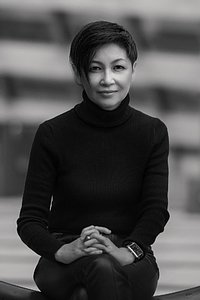
Artist Statement
Beyond sight Aesthetic insight
Just as there are infinite gradations between the light and shadow that make up the essence of photography, are there not also infinite forms that exist between living and non-living (organic and inorganic) The more I photograph nature, the more I wonder, how can we, today, perceive these in-between forms.
Even today, many landscapes exist in Japan that symbolize nature worship.
Extending from north to south in a long, thin constellation of islands, the Japanese archipelago is blessed with four distinct seasons and an abundance of fresh water, mountains, and sea. Here, appreciating the beauty of nature is a cultural tradition. I am affectionately proud of the values that have flourished within this natural context: the wabi-sabi aesthetic of imperfection and impermanence; the pursuit of subtle grace; the awareness that humans are a part of nature and are deeply entwined with its dynamics, both consciously and unconsciously. I wonder if this philosophical culture, characterized by empathy with nature, evolved not first and foremost from the natural landscape itself, but rather from the contemplation and perspectives of those who viewed it.
The continuous world of living and inanimate, three-dimensional and four-dimensional, visible and invisible, the reality in which we now live, allows for transcendental analogies between the macro and the micro. And this is where I believe the essence of 'abstraction' resides, and it is my job to represent it.
What is Sensegraphia?
Sensegraphia is a conceptual redefinition of photography, in which the visual aesthetics of the photograph are used to develop and express the sense of nature that enables us to recognize that humans are a part of nature and that we are centrally involved, both consciously and subconsciously, in nature's dynamics. Through fine art, Sensegraphia puts forward a philosophy and creative activities that reestablish the essential unity between people and nature, even within the context of today's highly advanced science and technology.
About the Logo
The design inside the circle is an abstraction of the Japanese characters meaning 'see' and 'feel'. The circle represents both the Earth and the traditional latticed windows of Japan, expressing Sensegraphia's photographic philosophy of using the window of our senses and the metaphor of the Earth to see and feel landscapes as fine art.
Biography
Eriko Kaniwa is a Tokyo-based digital artist who creates digital artworks based on her unique philosophy.
After a period of TV program production and social venture innovation, Kaniwa founded Sensegraphia in 2014, aiming to advocate a philosophy and creative practice that reconstructs the essential unity of people and nature through fine art. Also in 2014, she began developing a workshop program to apply the potential of photography and digital imagery to aesthetics education, presenting the program at domestic graduate schools, foreign companies, international conferences and think-tank business schools, where it received high acclaim.
She also spent two years exploring Japanese symbols of nature worship, represented by the so-called 'eight million gods' of Shintoism, examining how ancient Japanese perceived the natural environment and symbolized it as an object of prayer. She travelled to more than 20 locations throughout Japan, photographing torii gates built into the water, sacred married rocks, World Heritage Sites and other spiritual landscapes, and these images, along with her text, are included in her book "JOKEI - Symbols of Nature Worship, Sacred places in Japan".
After the difficulties of the global pandemic of the last few years, Kaniwa is currently working on a new theme. She is further learning and experimenting with the ways in which beings inhabit invisible dimensions that are continuous with visible reality, how they represent microscopic microbiological forms, and how these images bring a sense of oneness with nature to our perception.
Copyright (c) 2008-2024 by SENSEGRAPHIA- Eriko Kaniwa. All rights reserved.
All Images on this site are fully copyrighted, may not be used without written permission.

